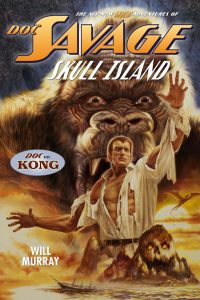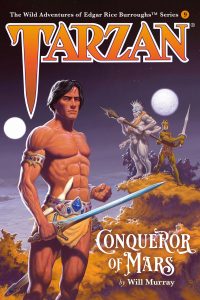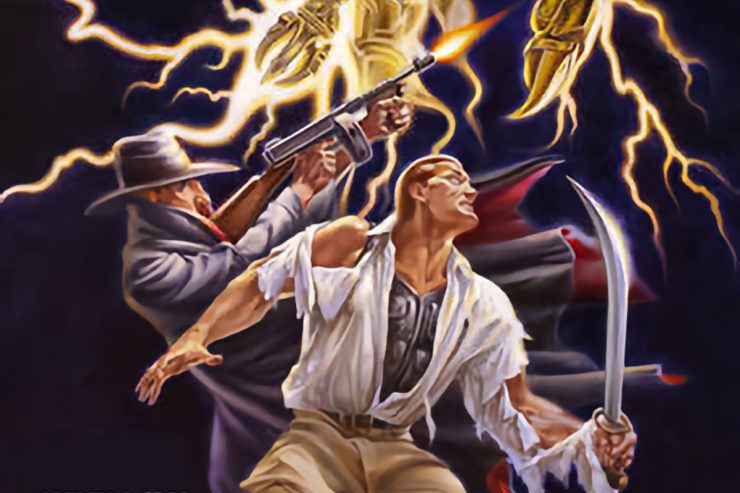Pulp magazines have influenced writers, artists, film directors, software developers, and countless others over the years. Our “PulpFest Profiles” focus on contemporary creators who have drawn inspiration from these rough-paper fiction magazines.

Prolific and popular author Will Murray has written extensively about Lester Dent’s Doc Savage, both officially licensed novels and articles about the hero. Will first discovered The Man of Bronze when he was fifteen and spotted THE DUST OF DEATH on a spinner rack. He began collecting pulp originals soon thereafter and started writing for fanzines, specifically about Doc Savage. In this interview, we do a deep dive with Will on his wide-ranging career as a pulp author.
Laurie Powers (LP): Tell us about how you went from being a fan to chronicling Doc Savage’s adventures?
Will Murray: In early 1969, I had just started buying paperback novels and was looking for something new. I was already reading Edgar Rice Burroughs, and I guess I was looking for something heroic. Maybe it was James Bama’s superheroic image of The Man of Bronze, but I bought that book, read it, and couldn’t get enough of them. I was soon writing articles for fanzines.
After reaching out to Lester Dent’s widow, Norma, we began an extensive correspondence. I eventually became the literary agent for the Dent estate. The sale of a previously unpublished Doc Savage novel — THE RED SPIDER — to Bantam Books opened the door to many things. PYTHON ISLE, my first Doc novel was based on a rejected Dent outline from 1934. Although it took a decade to reach print, when PYTHON ISLE was published, Bantam asked for more. I’ve now written 23 Doc Savage novels, most of them based on Lester Dent’s material.
LP: What were some of the challenges you faced when using Lester Dent’s unfinished work? And why have you written under the Robeson name?
Will Murray: When using Dent’s original material, I try to keep the regulars in character and the time period believable. My highest priority is to write like Lester Dent. I use the Kenneth Robeson pseudonym because it’s the traditional byline for Doc Savage novels. I also enjoy assuming the role of my own favorite author.
LP: Two of your Doc Savage novels, THE SINISTER SHADOW and EMPIRE OF DOOM, are crossovers between The Man of Bronze and The Shadow. Was it difficult to write these novels?
Will Murray: THE SINISTER SHADOW is set early in the careers of both Doc Savage and The Shadow. It evokes a gritty, Depression-era New York. I discovered an early, unpublished draft of Lester Dent’s only Shadow novel, “The Golden Vulture.” After I acquired the rights to include parts of this work, I blended them into my own storyline. It was a thrill to work with this vintage material.
EMPIRE OF DOOM takes place after both heroes have expanded their operations. Although I started with a brief Dent premise, I was largely on my own. The pressures of my mother’s passing and my expiring Condé Nast contract motivated me to create a very strong story. A high-adventure featuring super-scientific elements, I had the characters face The Shadow’s greatest foe, Shiwan Khan.
LP: SKULL ISLAND is another crossover, a pairing between Doc Savage and King Kong. Tell us more about it.

Will Murray: I was talking to my cover artist Joe DeVito about Doc’s 80th-anniversary release. He suggested a King Kong crossover. Affiliated with the Merian C. Cooper estate — the owner of Kong’s literary rights — Joe was able to grant me permission to write the novel. Of course, the characters were already connected. They had debuted within weeks of each other, and Kong toppled from Doc Savage’s skyscraper headquarters.
I dispensed with the Kenneth Robeson style for the book. Although I borrowed some from Edgar Rice Burroughs, it’s largely my own approach. That’s why it’s bylined, Will Murray.
LP: You’ve also written a Pat Savage novel.
Will Murray: Readers had long been requesting a Pat Savage novel, but I wasn’t sure it would work. I found an unrelated Dent outline and decided it was a good fit. With a solid foundation, I acquired the rights to do SIX SCARLET SCORPIONS. Lester had already established Pat’s entrepreneurial streak. So having her speculate in oil was enough to move her into the existing storyline. I teamed her up with Monk Mayfair for the interaction. Monk also made a great foil. I would love to write more novels, eventually pairing Pat with each of Doc’s men.
LP: Pat has always been a strong female character.
Will Murray: Kind of like my own Squirrel Girl, a comic book character that I’m very proud of. Steve Ditko — one of my favorite artists growing up — drew the first story. The character has become an empowerment figure — an inspiration for girls and young women.
LP: Tell us about some of the projects you’ve tackled more recently.
Will Murray: I’ve been very lucky that the licenses to characters I love have more or less fallen into my lap. When Doc started to slow down, I reached out to the late Joel Frieman of Argosy Communications. We worked out a deal to revive The Spider and other characters that he owned.
The Spider is probably the most psychologically adult of all the pulp heroes. I’ve just finished FURY IN STEEL, my second Spider novel. I’m looking forward to doing another, featuring the arch-villains The Octopus and The Scorpion. I’m going to finally explain the mystery behind them. It will be called SCOURGE OF THE SCORPION. I’ve always found the Spider fascinating in a demented kind of way. He’s a manic-depressive, paranoid schizophrenic with a messiah complex.
LP: You’ve also written three Tarzan novels. Tell us about your association with both the character and the Edgar Rice Burroughs team.

Will Murray: Readers had asked me to try my hand at Tarzan. Joe DeVito’s connection to the Burroughs organization helped open the door for me.
Jim Sullos and Chris Carey of Edgar Rice Burroughs, Inc. have been great to work with, reviewing my manuscripts carefully and helping to resolve any issues. Originally, TARZAN, CONQUEROR OF MARS ended with the ape-man dealing with an enemy in a manner consistent with ERB’s portrayal of the character. Times have changed. At their urging, I rewrote the ending several times until we agreed I had it right. It was all very satisfying.
I discovered John Carter of Mars years before Tarzan. The Warlord of Mars is still one of my favorites, but Tarzan has now captured my imagination. I would love to do more stories featuring the character.
LP: According to your introduction to THE WILD ADVENTURES OF SHERLOCK HOLMES, you prefer traditional Sherlock Holmes stories. However, you’ve written less traditional tales, such as “The Adventure of the Reckless Resurrectionist.”
Will Murray: Holmes encounters Colonel Richard Henry Savage, the real-life soldier of fortune who inspired Doc Savage, in one of my earliest Holmes stories. In the anthology, SHERLOCK HOLMES AND DOCTOR WAS NOT, I had to feature a doctor other than Watson. I chose H. P. Lovecraft’s Herbert West. However, I also included Watson. So my traditional urges were strong.
I jumped at the chance when MX Books editor David Marcum asked me for a traditional Sherlock Holmes tale. Upon accepting “The Adventure of the Glassy Ghost,” Marcum asked for another. Now I’m writing a new Sherlock Holmes story almost every other month. Not that I think I’m Conan Doyle, but I find them easy to write. It’s fascinating how many different mysteries I can imagine for Holmes and Watson to solve.
LP: When it comes to the Street & Smith line, you’re a veritable encyclopedia. You’ve also written books and articles about many other pulps. WORDSLINGERS: AN EPITAPH FOR THE WESTERN, and “The Thrill Book Story” — an article for PULP VAULT — are good examples.
Will Murray: WORDSLINGERS is kind of a magnum opus. It’s a history of the pulp magazine industry as viewed through the perspective of the western titles. It uses actual quotes, allowing the magazines’ editors, writers, and others to tell the story. The technique was an outgrowth of my work for STARLOG magazine where I’d weave multiple interviews together into a coherent whole.
I’ve written tons of articles on H. P. Lovecraft, one of my favorite authors, and over 100 introductions for Altus Press/Steeger Books and other publishers. I try to provide historical context on the stories and their authors. I’m currently writing a column called “Will Murray’s 20th Century Panopticon” for RETROFAN magazine. I get to discuss old TV shows such as THE MANY LOVES OF DOBIE GILLIS, HONEY WEST, and THE MAN FROM U.N.C.L.E. I’ve also delved into immortal pop culture characters like Casper the Friendly Ghost and Archie Andrews. Recently, I explored the influence of The Spider on Marvel’s Spider-Man. I enjoy spreading my wings.
LP: For those who want to write or illustrate new stories about pulp characters, or reprint the original stories, do you have any advice?

Will Murray: The pulps are filled with yet to be discovered stuff. There’s a lot more to be learned and tons of creators deserving rediscovery. Start digging into the people behind the bylines. They were real people who led their own lives. Bring them to life as individuals. Often, they left behind some great stories.
For example, most readers know nothing about BLACK MASK writer Ed Lybeck. But his work is really good. Although he wrote only a few stories, he was considered to be a major new MASK writer in the 1930s. Looking for information about him, I learned that he had an interesting life. I brought him to the attention of Matt Moring and Steeger Books recently reprinted Lybeck’s BLACK MASK stories in one volume.
LP: What can we expect from Will Murray in the future?
Will Murray: While knocking out more Sherlock Holmes stories, I’m waiting for the release of my new Spider novel. THE WILD ADVENTURES OF CTHULHU will collect ten of my best Cthulhu Mythos stories. I have a terrific idea for a sequel to TARZAN, CONQUEROR OF MARS.
I’d like to do an expanded edition of THE DUENDE HISTORY OF THE SHADOW MAGAZINE. It’s forty years old and I think it deserves a second edition. People would like to see another volume of Doc Savage articles. I’d also like to collect my best general pulp articles. Then there’s the Lester Dent biography I’ve been writing for years. All these projects take time and effort. I can only do a few at a time. And who knows what surprising new opportunities may come my way?
(To learn more about Will Murray and his work, visit Adventures in Bronze, home to “The Wild Adventures of Doc Savage” and more.
Laurie Powers is the granddaughter of pulp author Paul S. Powers. She was introduced to the pulp community in 2007 through the publication of PULP WRITER: TWENTY YEARS IN THE AMERICAN GRUB STREET, her grandfather’s memoir of writing for the pulps. She has also edited several collections of her grandfather’s work in various genres, releasing a number of previously unpublished stories. Laurie is the author of QUEEN OF THE PULPS: THE REIGN OF DAISY BACON AND LOVE STORY MAGAZINE, published by McFarland Books in 2019. A resident of Virginia, she was awarded the Munsey Award in 2016.
Joe DeVito painted the jacket art for DOC SAVAGE: THE EMPIRE OF DOOM — one of two novels pairing the Man of Bronze with The Shadow — and SKULL ISLAND. He is the regular artist for Will Murray’s “The Wild Adventures of Doc Savage” and other series.
Will Murray’s TARZAN, CONQUEROR OF MARS features a wrap-around cover painting by award-winning illustrator Romas Kukalis. It was published by Edgar Rice Burroughs, Inc. in 2020.
J. W. Schlaikjer’s jacket painting for Ed Lybeck’s DEAD EVIDENCE: THE COMPLETE BLACK MASK CASES OF HARRIGAN (Steeger Books, 2020), originally graced the cover to the April 1932 issue for BLACK MASK. Schlaikjer painted about fifty covers for the hardboiled detective pulp.)







